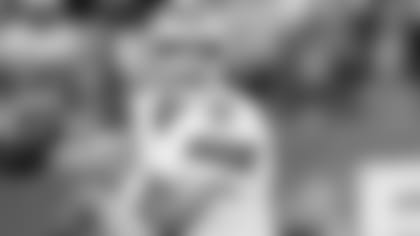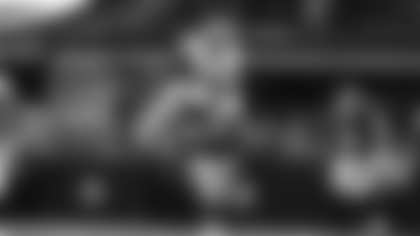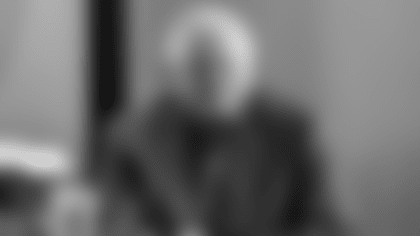When the Cowboys signed quarterback Tony Romo as an undrafted free agent in 2003, the odds were obviously not in his favor. While drafted players obviously find more success than undrafted ones, the gap is a massive one for quarterbacks; most of the elite ones are selected in the first two rounds, and the chances of hitting on an undrafted free agent out of Eastern Illinois weren't great for Dallas.
In addition to Romo's small-school background and undrafted status, there was another factor working against him: his height. At 6-2, Romo is considered short for a passer. And historically, quarterbacks at Romo's height haven't found too much success in the NFL. Below, I tracked the approximate value per season generated by every quarterback drafted between 2000 and 2010.

Pretty clear. Tall quarterbacks have long reigned supreme, but why? The traditional theory is that they need to be able to see over the offensive line, but that doesn't really make much sense when you think about it, right? Quarterbacks typically throw through passing lanes, not over the top of their linemen, regardless of their height.
Instead, I subscribe to a theory proposed by Philadelphia Eagles coach Chip Kelly that quarterbacks don't thrive because they're tall, but rather because they have big hands. Passers need to be able to control the football at all times. They need to hold onto it in a crowded pocket, pump fake, control it on play-action and direct it with ease as they throw – and big hands allow for all of those things.
If true, the big-hand theory would be why it appears quarterbacks succeed because of their height; height is obviously strongly correlated with hand size. Taller quarterbacks post outstanding numbers, but it might very well be due to their mitts instead of their height.
It's worth noting that two of the shortest (and best) quarterbacks in the NFL, Drew Brees and Russell Wilson, have unusually large hands. Brees (6-0) and Wilson (5-11) both have hands that measure 10.25 inches, shockingly large for their height. In comparison, Romo's hands are just under nine inches. Quite a difference.
None of this is to bash Romo, of course; it's remarkable that he's been able to become one of the league's top quarterbacks (yes, he is) despite the odds being stacked against him. But to search for another Romo-like quarterback simply because he turned out well would be a mistake. The probability of hitting on another short, undrafted pocket passer with small hands isn't exactly outstanding.
But the Cowboys do need to at least entertain the thought of finding their quarterback of the future, whether it's now or in 2015. At some point, Romo's time will end, and the future of the team will fall into another quarterback's (hopefully large) hands.
So the question for Dallas is, when that time comes, how can they find another diamond in the rough? The Cowboys clearly aren't going to be looking for a quarterback in the first round of this year's draft – they could very well not draft one at all – so chances are they'll need to uncover a Russell Wilson/Tom Brady-esque late-round steal.
To do that, they'll need to search for specific traits that most other teams are overlooking. We know that NFL teams care about height, and we know it's correlated with success at the quarterback position. But how many teams really care about hand size? Probably not as many.
Since teams overpay for quarterback height, I created a metric I labeled "hand size rating" to determine the relationship between a quarterback's height and his hand size. By dividing hand size (what teams should emphasize) into height (what they do emphasize), we can get a good idea of how a player's actual value matches up with his perceived value. The smaller the number, the better.
For example, former Vikings quarterback Daunte Culpepper stood 6-4 (76 inches), but had only 9.5-inch hands. Our height-to-hand calculation for him would be 76 divided by 9.5, or 8.0. Meanwhile, Brees stands only 6-0 (72 inches) but has 10.25-inch hands. His "hand size rating" would be just 7.02.
Below, I calculated the "hand size rating" for some of the quarterback prospects in this draft. Again, a smaller number indicates large hands relative to height – a good thing. For fun, I also added in a few current NFL signal-callers.
Player (School): Height, Hand Size – Hand Size Rating
Russell Wilson (NC State): 5-11, 10.25 – 6.93
Brett Favre (Southern Miss): 6-2, 10.63 – 6.96
Drew Brees (Purdue): 6-0, 10.25 – 7.02
Ryan Nassib (Syracuse): 6-2, 10.18 – 7.27
E.J. Manuel (Florida State): 6-5, 10.38 – 7.42
Matt Barkley (USC): 6-3, 10.08 – 7.44
Marqueis Gray (Minnesota): 6-3, 9.78 – 7.67
James Vandenberg (Iowa): 6-3, 9.68 – 7.74
Geno Smith (West Virginia): 6-2, 9.28 – 7.97
Daunte Culpepper (Central Florida): 6-4, 9.50 – 8.00
Alex Smith (Utah): 6-4, 9.38 – 8.10
Matt Scott (Arizona): 6-2, 9.08 – 8.15
Colby Cameron (Louisiana Tech): 6-2, 9.08 – 8.15
Zac Dysert (Miami of OH): 6-3, 9.18 – 8.17
Mike Glennon (NC State): 6-7, 9.58 – 8.25
Sean Renfree (Duke): 6-3, 9.08 – 8.26
Landry Jones (Oklahoma): 6-4, 9.18 – 8.28
Collin Klein (Kansas State): 6-5, 9.28 – 8.30
Jason Campbell (Auburn): 6-4, 9.13 – 8.32
Tony Romo (Eastern Illinois): 6-2, 8.88 – 8.33
Tyler Bray (Tennessee): 6-6, 9.28 – 8.41
Anything under 8.0 is a good score because it means the quarterback is probably [embedded_ad]
"undersized," so teams might overlook him, but he still has the hand size needed to be a capable NFL quarterback. Had teams emphasized hand size over height, there's a good chance Brees and Wilson wouldn't have fallen so far in the draft. The same goes for Favre with the second-best hand size rating of the bunch.
If the Cowboys are searching for a mid to late-round pick who could eventually take over the offense, whether it's in this year's draft or not, they should be looking for traits that predict NFL success but that others aren't valuing. Hand size is one of them.















